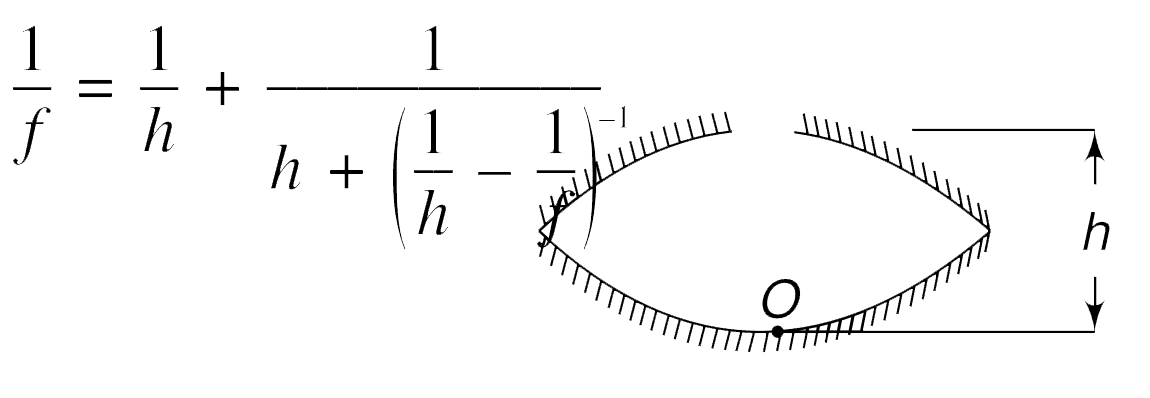Two spherical concave mirrors of equal focal length are put against each other with their reflecting surfaces facing each other. The upper mirror has an opening at its centre. A small object (O) is kept at the bottom of the cavity so formed (see Figure). The top mirror produces a virtual image of the object and the lower mirror then creates a real image of the virtual image. The second image is created just outside the cavity mouth. This creates an optical illusion as if the object is raised above its original position.
(a) Prove that the height h shown in the Figure is related to focal length of the mirror as
1f=1h+1h+(1h−1f)−1
(b) Rewrite the above equation in terms of x=hf and solve if for x.

The correct Answer is:(b) x=1
Step by step video, text & image solution for Two spherical concave mirrors of equal focal length are put against each other with their reflecting surfaces facing each other. The upper mirror has an opening at its centre. A small object (O) is kept at the bottom of the cavity so formed (see Figure). The top mirror produces a virtual image of the object and the lower mirror then creates a real image of the virtual image. The second image is created just outside the cavity mouth. This creates an optical illusion as if the object is raised above its original position. (a) Prove that the height h shown in the Figure is related to focal length of the mirror as (1)/(f) = (1)/(h) + (1)/(h+((1)/(h)-(1)/(f))^(-1)) (b) Rewrite the above equation in terms of x = (h)/(f) and solve if for x. by Physics experts to help you in doubts & scoring excellent marks in Class 12 exams.
Updated on:21/07/2023Topper's Solved these Questions
- GEOMETRICAL OPTICSBOOK - ARIHANTCHAPTER - GEOMETRICAL OPTICSEXERCISE - Level 3
9 Videos
- GEOMETRICAL OPTICSBOOK - ARIHANTCHAPTER - GEOMETRICAL OPTICSEXERCISE - Level 3
9 Videos
- ELECTROSTATICSBOOK - ARIHANTCHAPTER - ELECTROSTATICSEXERCISE - Level 3
59 Videos
- MAGNETIC EFFECT OF CURRENTBOOK - ARIHANTCHAPTER - MAGNETIC EFFECT OF CURRENTEXERCISE - Magnetic effect of Current
45 Videos
Similar Questions
Knowledge Check
A mirror forms a virtual image of a real object
AIt must be a convex mirror.BIt must be a concave mirror.CIt must be a plane mirror.DIt may be any of the mirrors mentioned above.A concave mirror produces a virtual, erect image when the object is ______
Abetween F and CBat FCbeyond CDbetween pole and FAssertion : Concave mirror can produce virtual image of virtual object.
Reason : Convex mirror cannot form image of virtual object.AIf both assertion and reason are correct and rason is a correct explanation of the assertion.BIf both assertion and reason are correct but reason is not the correct explanation of assertion.CIf assertion is correct but reason is incorrect.DIf both assertion and reason are incorrect.
When does a concave mirror form a virtual image ?
View SolutionName the mirror that can give real as well as virtual image of an object.
View SolutionA concave mirror of focal length/produces a real image n times the size of the object. What is the distance of the object from the mirror ?
View SolutionA : Plane and convex mirrors can produce real images of objects.
R : A plane of convex mirror can produce a real image if the object is virtual.
View SolutionA concave mirror of focal length f produces a real image n times the size of the object. The distance of the object from the mirror is
View Solution
